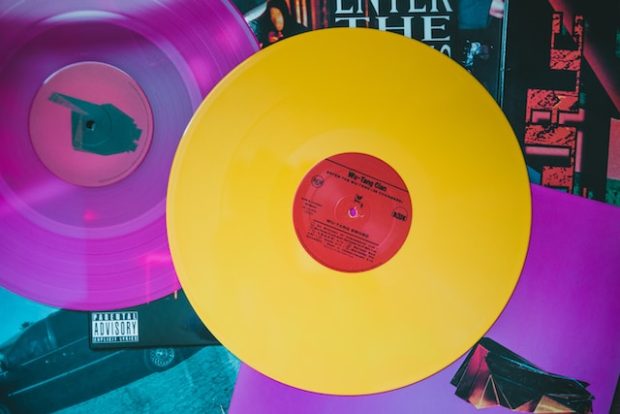Album covers serve as a visual symphony, harmonizing the music within with the cultural and fashion zeitgeist of their time. As we journey through the decades, these covers not only chart the evolution of music but also the sartorial statements that defined generations, covering different record types and genres.
Cultural and Societal Influences
Music and fashion have always been intertwined, reflecting the broader cultural and societal shifts of their respective eras. The civil rights movement, feminist wave, and countercultural revolutions of the ’60s and ’70s, for instance, influenced artists to adopt more rebellious and statement-making attire. The economic boom of the ’80s brought with it a penchant for luxury and excess, mirrored in the glamorous and ostentatious outfits of pop icons. As the digital age dawned, artists began to experiment, blending past trends with futuristic elements, reflecting society’s grappling with tradition and modernity.
The 1950s: Rock ‘n’ Roll and Polished Looks
Elvis Presley’s “Elvis Presley” (1956): The King, in his high-collar jacket, became emblematic of the decade’s polished yet rebellious demeanor.
Billie Holiday’s “Lady in Satin” (1958): Holiday’s elegant off-shoulder dress and gloves epitomized the sophisticated fashion of the ’50s jazz scene.
The 1960s: Psychedelia and Mod Fashion
The Beatles’ “Sgt. Pepper’s Lonely Hearts Club Band” (1967): The Edwardian-inspired uniforms and vibrant colors mirrored the psychedelic era’s flamboyance.
The Supremes’ “Where Did Our Love Go” (1964): Their matching sequined gowns showcased the decade’s love for coordinated group outfits.
The 1970s: Glam Rock, Disco Fever, and Folk Simplicity
David Bowie’s “Aladdin Sane” (1973): The iconic lightning bolt makeup and fiery hair became synonymous with glam rock’s androgynous allure.
Fleetwood Mac’s “Rumours” (1977): Stevie Nicks’ bohemian lace shawl and layered necklaces captured the era’s folk-inspired fashion.
The 1980s: Pop Extravaganza, Punk Rebellion, and New Wave Cool
Madonna’s “Like a Virgin” (1984): Her lace ensemble, chunky jewelry, and iconic belt set the tone for ’80s pop fashion.
The Smiths’ “The Queen Is Dead” (1986): The vintage monochrome photo echoed the new wave’s retro-inspired, understated style.
The 1990s: Grunge, Hip-Hop Streetwear, and Pop Princesses
Nirvana’s “Nevermind” (1991): While the cover focused on a baby in a pool, the band’s flannel shirts and distressed jeans became the grunge uniform.
TLC’s “CrazySexyCool” (1994): Their baggy pants, cropped tops, and oversized hats defined ’90s hip-hop and R&B fashion.
The 2000s: Bling Era, Indie Quirk, and Emo Angst
OutKast’s “Stankonia” (2000): The duo’s flashy outfits against the black and white American flag backdrop encapsulated the bling era’s extravagance.
My Chemical Romance’s “Three Cheers for Sweet Revenge” (2004): The band’s dark, moody attire became emblematic of the 2000s emo and punk revival.
The 2010s: Eclecticism, Digital Art, and Genre Fusion
Lady Gaga’s “Born This Way” (2011): Gaga’s transformation into a motorcycle showcased the decade’s penchant for digital art and avant-garde fashion.
Tyler, The Creator’s “IGOR” (2019): His pastel suit, blonde wig, and sunglasses reflected the 2010s’ embrace of genre-blending and fluid fashion.
Fashion Collaborations
Over the years, musicians have often collaborated with fashion designers to create iconic album cover looks. Madonna’s partnership with Jean Paul Gaultier for her “Like a Virgin” ensemble or Lady Gaga’s frequent collaborations with designers like Alexander McQueen and Giorgio Armani are testament to this symbiotic relationship. These collaborations not only elevated the visual appeal of album covers but also set fashion trends, with fans eager to emulate their favorite stars.
Album Release Events and Fashion Shows
The lines between music launches and fashion events have increasingly blurred. Kanye West’s “The Life of Pablo” listening party doubled as a Yeezy fashion show, showcasing his latest clothing line. Rihanna, too, combined her love for music and fashion by launching her Fenty brand alongside her albums. These events highlight how intertwined music and fashion have become, with album releases now serving as platforms for broader cultural statements.
Conclusion
Album covers, in their visual splendor, offer a sartorial history lesson. They encapsulate moments, moods, and movements, reminding us that fashion, like music, is a reflection of the times. As we stream our favorite tracks in this digital age, pausing to appreciate the artistry of album covers can transport us to eras defined by distinct fashion rhythms. Through collaborations, societal influences, and grand release events, the legacy of album cover fashion continues to resonate, echoing the timeless dance between music and style.
Read More:


